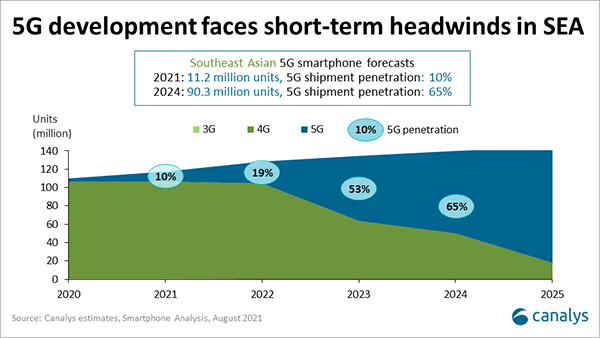A combination of COVID-19 and component shortages is decimating the potential for smartphone market recovery in Southeast Asia*. Canalys predicts shipments will grow 7% this year but will still be lower than pre-pandemic 2019 and will not improve until 2022.
COVID-19 and the macroeconomy
Southeast Asia has seen repeated waves of COVID-19, but unlike many regions, the vaccination drive has not been strong enough to offset the severity of cases. Governments are scrambling to regain control, but citizens are now voicing their discontent, with passionate protests in Thailand as tensions rise. Expansionary monetary policy has struggled to jumpstart the economy and has accelerated inflation as small businesses buckle under poor domestic demand. The bleak economic outlook is threatening jobs, key industries, such as tourism, and consumers’ disposable income.
There are some signs of recovery, as the UN COVAX scheme is allocating vaccines. And many developed regions have donated to countries of strategic importance, such as Vietnam, which is vital for technology supply chains. But as early data about the long-term efficacy of mRNA vaccines appears concerning, the big risk is that developed nations instead use extra vaccines to give their vulnerable citizens a third dose, or vaccinate children, and Southeast Asia stays undersupplied.
Smartphones, however, remain a necessity for many citizens. Remote work and education have created new use cases for smartphones in Southeast Asia, in contrast to the US, China and Europe, where people have gravitated toward laptops and tablets to fulfil these needs. So, while the need for smartphones remains high, people’s capacity to buy them is not. In a perfect world, smartphone vendors would expand their ranges and allocation of low-end phones to meet this need. But the other major challenge, component shortages, makes this impossible.
Component shortages and pricing
The impact of chip shortages is being felt around the world. But it is particularly bad in Southeast Asia, as global brands are de-prioritizing their low-end devices and developing regions as they try to allocate volume to the most lucrative products and markets possible. Inside Southeast Asia, country managers of various brands are squabbling to secure device allocation. As the shortage is not expected to end until 2022, smartphone prices are likely to rise between 10% to 15% in Southeast Asia. And the heightened cost of air freight is only serving to exacerbate the problem.
5G development

The clamor around 5G is now reaching a crescendo, with governments, telcos and smartphone vendors all touting the technology. But 5G is not yet a commercial reality for most consumers in Southeast Asia. In my opinion, this noise is just empty marketing by smartphone vendors and telcos to showcase themselves as the trendiest, most technologically advanced companies. As 5G deployment is resource-intensive, and the price of 5G for customers is 15% to 25% more than 4G, the outlook for further penetration is sluggish.
Channel trends
COVID-19 has presented huge challenges for channels. Malaysia, for example, has been hit especially hard by the pandemic, as footfall in shopping centers has dwindled to 10% to 30% of pre-pandemic levels. As retailers consider store closures, a negative cycle could emerge, as weak customer spending causes businesses to suffer, and business pressure causes more layoffs and restructuring.
One silver lining of the pandemic is the use of ecommerce, which has prompted the digitalization of retail. I expect this growth momentum to continue in Southeast Asia, as smartphone vendors slowly shift their marketing budgets toward online to appeal to younger demographics. In the short term, though, bricks and mortar stores will remain the primary sales channel, as ecommerce channels still lack warehousing and freight capacity for broad geographical fulfilment at scale.
*Note: Southeast Asia refers to: Indonesia, Laos, Malaysia, Myanmar, Philippines, Singapore, Thailand, Vietnam.
Share this article
CATEGORY
- All
- Canalys Forums
- Canalys Forums,Channels
- Canalys Forums,Channels,Partner Program
- Canalys Forums,Channels,Sustainability
- Canalys Forums,Sustainability
- Enterprise
- Market
- Market,Canalys Forums,Channels
- Market,Canalys Forums,Channels,Cloud
- Market,Canalys Forums,Channels,Sustainability
- Market,Channels,PC
- Market,PC
- Market,Smartphone
- Market,Technology,AR/XR/VR
- Market,Technology,Automotive
- Market,Technology,Canalys Forums,Channels
- Market,Technology,Canalys Forums,Channels,Cloud
- Market,Technology,Channels
- Market,Technology,Channels,Cloud,Partner Program
- Market,Technology,Smart Personal Audio
- Market,Technology,Smart Speaker
- Market,Technology,Smartphone
- Smart Personal Audio
- Smartphone
- Technology
- Technology,Canalys Forums,Channels,Security
- Technology,Channels
- Technology,Channels,Cloud,Partner Program
- Technology,Channels,Partner Program
- Technology,Unified Communications
- Technology,Wearable Band

.png)

